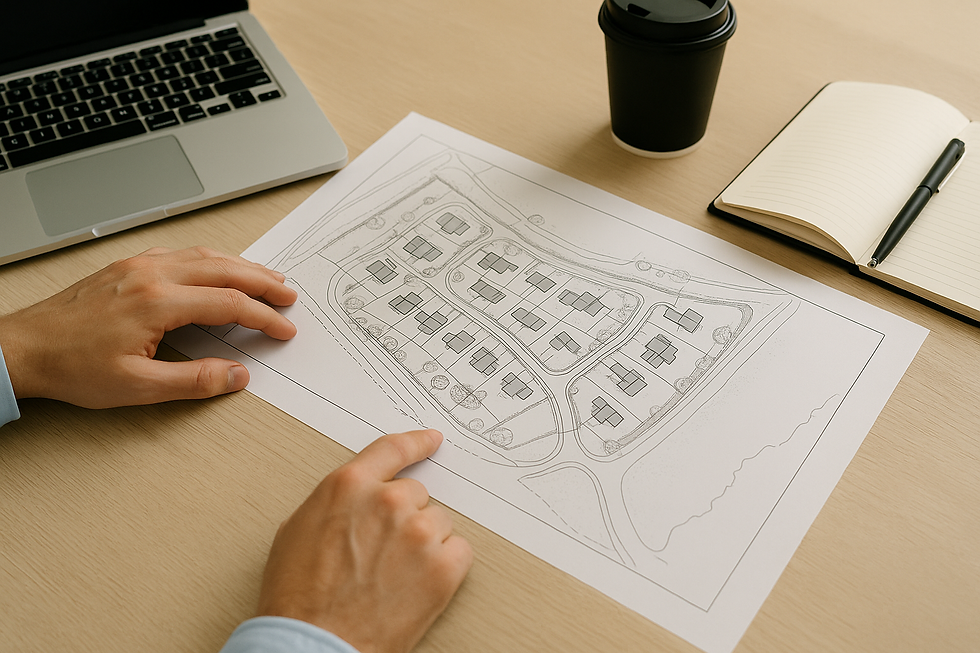The Most Sustainable Cladding Options in the UK: A Complete Guide
- Ty Green Ltd.

- Aug 13
- 3 min read
The most sustainable cladding options in the UK are UK-grown timber (such as larch or cedar), UK-sourced thermally modified hardwoods, and even steel sheets. UK-grown timber is renewable, low-carbon, and biodegradable. Thermally modified wood offers enhanced durability without chemicals, and when sourced and processed in the UK, keeps transport emissions low. Box profile steel is 100% recyclable, often made from recycled material, and can last 30+ years with minimal maintenance, making it a cost-effective and low-impact choice.
When we talk about sustainability in construction, cladding choice is one of the most overlooked decisions. It’s easy to get caught up in style and colour, but the materials you wrap a building in have a huge impact on its environmental footprint, long-term maintenance needs, and even the health of the spaces inside.
At Ty Green, we focus on materials that are durable, low-impact, and responsibly sourced. This guide looks at the most common cladding types in the UK, with an honest look at their strengths, weaknesses, and typical costs, so you can make an informed choice.
UK-Grown Timber Sustainable Cladding
Examples: Larch, cedar.
Using UK-grown timber keeps transport miles low, supports the local forestry industry, and locks carbon into the building fabric. It’s a renewable resource that, at the end of its life, can return to the earth without leaving harmful residues.
With the right detailing and finish, UK larch can last 20–30 years. Timber cladding is breathable, helping regulate moisture and avoiding trapped condensation.
Typical cost: £40–£65 per m² supplied (planed profile) depending on species, profile, and grade, plus finishing if required.
Sustainability verdict: One of the best all-round choices for a natural, breathable finish - especially when sourced from well-managed UK forests.

Thermally Modified Wood Cladding
Thermally modified timber has been heat-treated to improve its durability and stability without using chemical preservatives. The process changes the wood structure at a cellular level, making it more resistant to decay, swelling, and shrinking.
In the UK market, a lot of thermally modified timber is imported (often from North America or mainland Europe) which can increase its embodied carbon. That said, our supplier offers UK-grown and UK-processed thermally modified hardwoods, such as ash, which dramatically reduces transport impact while still delivering the performance benefits.
Typical cost: £60–£90 per m² supplied, reflecting its enhanced durability and longer lifespan.
Sustainability verdict: A highly durable, low-maintenance option with strong environmental credentials when sourced and processed in the UK.
Box Profile Steel Cladding
Steel may not be the first thing people think of when they hear “sustainable,” but in the right context it’s one of the most environmentally responsible options.
Modern box profile steel sheets often contain a high percentage of recycled material and can be 100% recycled at the end of their life. They’re incredibly long-lasting (30 years or more is normal) and require very little maintenance. This means less repainting, fewer replacements, and lower overall resource use over the building’s lifetime.
They also perform well in tough weather, making them ideal for rural and coastal locations.
Typical cost: £25–£40 per m² supplied, making it one of the most cost-effective long-life cladding materials.
Sustainability verdict: Excellent for long-life, low-maintenance buildings where you want minimal environmental impact over decades of use.

Other Common Cladding Materials (and Why We Avoid Them)
uPVC: Low cost up front (£20–£35 per m²) but made from non-renewable petrochemicals, with a limited lifespan and poor recyclability.
Fibre Cement: £40–£55 per m², durable but high embodied energy from cement production and difficult to recycle.
Composite Boards: £50–£70 per m², often contain plastics and bonding resins. While marketed as “low maintenance,” they can fade over time and are not biodegradable.
These materials have their place, but for projects focused on true sustainability, they often fall short.
How to Choose the Right Sustainable Cladding
When selecting cladding, it’s worth considering:
Lifespan: Match the cladding’s durability to the intended life of the building.
Maintenance: Lower maintenance often means fewer resources used over time.
Embodied Carbon: Look at the carbon emissions created during manufacturing.
End-of-Life: Can it be recycled, reused, or biodegraded?
Source: Locally sourced materials reduce transport emissions and support the regional economy.
Budget: Consider not just supply cost, but also installation, finishing, and long-term maintenance.
Our Approach at Ty Green
We prioritise UK-grown timber, UK-modified thermally treated hardwoods, and box profile steel because they consistently offer the best balance of durability, low environmental impact, and aesthetic appeal. These materials fit within our ethos of creating sustainable spaces that are healthy and enjoyable to live in, without compromising on style or performance.
Whether you’re building a garden room, a glamping pod, or a full-scale home, your cladding choice is a long-term investment. Choosing responsibly now means less waste, less maintenance, and a building that performs beautifully for decades.



Comments